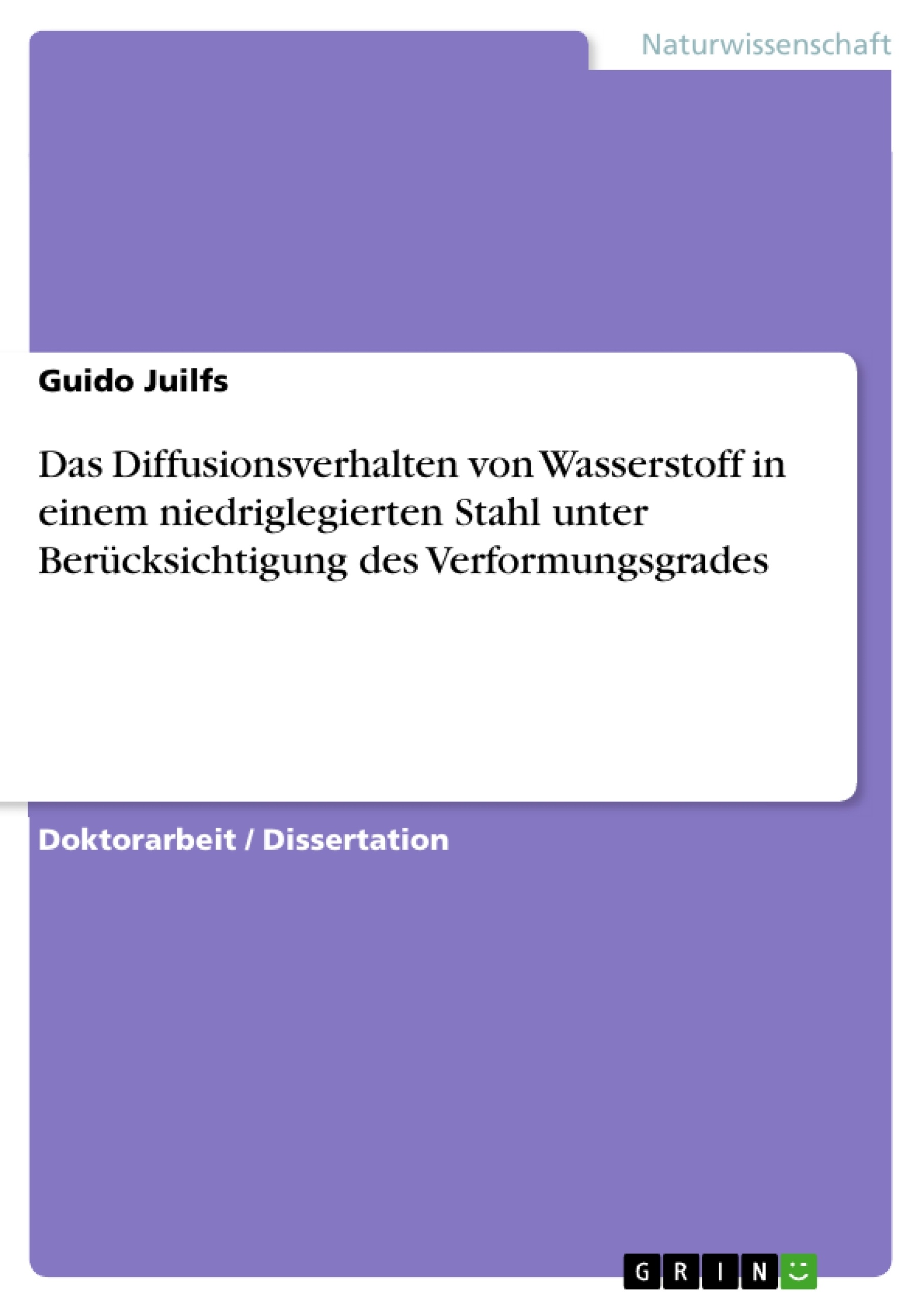The influence of plastic strain on the diffusion behaviour of hydrogen in a low alloyed structural steel (FeE 690T) was investiated using the electrochemical permeation technique. The plastic deformation was introduced either by cold rolling or by tensile straining. It was shown, that the apparent diffusion coefficient depends on the plastic strain and on the overall hydrogen concentration, whereas the maximum hydrogen flux remained almost unchanged. These observations are interpreted in terms of variations in the dislocation density, which act as ′sinks′ for the diffusable hydrogen atoms. Together with the results of a previous study on the fracture toughness of FeE 690T in the presence of hydrogen the permeation data obtained in this work suggest that the observed influence of deformation rates on the fracture mechanism can be attributed to the reduced mobility of hydrogen atoms in the plastic zone. The assumption that the hydrogen transport during monotonic straining is controlled by diffusion was confirmed by investigations concerning the formation of surface films. Using a potentiodynamic method (cyclovoltammetry) a characterisation of the surface reactions involved in permeation experiments was performed. It was shown that the nature of the passive layers forming on the surface depens on the applied potential, affecting mainly the hydrogen absorption reaction. The hydrogen entry is assumed to preferably take place at so called ′active sites′ on the metal surface.
Inhaltsverzeichnis
- Zusammenfassung
- Abstract
- Liste der verwendeten Symbole
- 1 Einleitung
- 2 Experimentelle Methodik
- 2.1 Werkstoff und Probenherstellung
- 2.2 Elektrochemische Permeationstechnik
- 2.2.1 Prinzip der elektrochemischen Permeationstechnik
- 2.2.2 Durchführung der Permeationsmessungen
- 2.2.3 Bestimmung des effektiven Diffusionskoeffizienten
- 2.3 Proben für C(T)-Messungen
- 2.4 C(T)-Messungen
- 2.5 Cyclovoltammetrie
- 3 Ergebnisse
- 3.1 Einfluss plastischer Verformung auf den Wasserstofftransport
- 3.1.1 Kaltgewalzte Proben
- 3.1.2 Zugverformte Proben
- 3.2 Modellrechnung für den Wasserstofftransport
- 3.3 Einfluss der Deckschichtbildung auf den Wasserstofftransport
- 4 Diskussion
- 4.1 Vergleich der Ergebnisse mit theoretischen Modellen
- 4.2 Der Einfluss der Fallendichte auf die Wasserstoffdiffusion
- 4.3 Der Dehnrateneffekt
- 4.4 Bedeutung für die Risszähigkeit
- 4.5 Deckschichtbildung
- 4.6 Weitere Forschungsarbeiten
- 5 Zusammenfassung und Schlussfolgerung
Zielsetzung und Themenschwerpunkte
Die Dissertation untersucht den Einfluss der plastischen Verformung auf das Diffusionsverhalten von Wasserstoff in einem niedriglegierten Baustahl (FeE 690T) unter Berücksichtigung des Verformungsgrades und der Deckschichtbildung in alkalischen Medien.
- Bestimmung des Einflusses der plastischen Verformung auf den Wasserstofftransport
- Entwicklung eines Modells zur Beschreibung des Wasserstofftransports in Abhängigkeit von der Fallendichte
- Untersuchung der Deckschichtbildung und deren Einfluss auf den Wasserstofftransport
- Analyse des Dehnrateneffekts und seiner Bedeutung für die Risszähigkeit
- Vergleich der experimentellen Ergebnisse mit theoretischen Modellen
Zusammenfassung der Kapitel
- Kapitel 1: Die Einleitung stellt die Problematik der Wasserstoffdiffusion in metallischen Werkstoffen dar und führt in das Thema der Dissertation ein.
- Kapitel 2: Es werden die experimentellen Methoden, die in der Dissertation verwendet werden, vorgestellt und beschrieben. Dies umfasst die elektrochemische Permeationstechnik, die C(T)-Messungen und die Cyclovoltammetrie.
- Kapitel 3: Die Ergebnisse der durchgeführten Messungen werden vorgestellt und analysiert. Hierbei wird der Einfluss der plastischen Verformung auf den Wasserstofftransport, der Einfluss der Deckschichtbildung und die Modellierung des Wasserstofftransports im Detail diskutiert.
- Kapitel 4: Die Ergebnisse werden im Kontext bestehender theoretischer Modelle diskutiert und die Bedeutung der Erkenntnisse für die Risszähigkeit von Baustahl wird erörtert.
Schlüsselwörter
Wasserstoffdiffusion, plastische Verformung, Baustahl, elektrochemische Permeationstechnik, Deckschichtbildung, Modellrechnung, Dehnrateneffekt, Risszähigkeit.
- Quote paper
- Guido Juilfs (Author), 2000, Das Diffusionsverhalten von Wasserstoff in einem niedriglegierten Stahl unter Berücksichtigung des Verformungsgrades, Munich, GRIN Verlag, https://www.grin.com/document/5081




